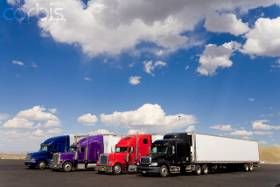Got My Permit!
Topic 429 | Page 2

The pre trip inspection will be the hardest to remember and do right. But really, if you have the time, get yourself thru ALL of the High Road...it will set you up really well when you hit that classroom. You'll be wayyy ahead of the rest of them, and it will definitely show to the instructors. And thats what you want to do...stand out. So grind thru the High Road...its worth your time.

Well, I have everything but the actual CDL-A (have a learner's) and HAZMAT. The reason for that is technically because I have to wait to move and test for HAZMAT in my new state since it doesn't transfer, but I've been finding memorizing the rules for the various divisions and classes to be challenging.
Honestly, the rest seems to be easier once you get your hands on a rig. I remember feeling the same way when I was doing classroom work for my CDL-B. It didn't make much sense on paper, but once I was able to look at, touch, climb on and under an actual bus, it became more a matter of losing my voice before finishing doing the verbal pre-trip.
When you do study for the pre-trip, practice saying everything out loud because it can be hard to remember to verbalize an activity. This is how I failed my EMT practical the first time. I said "I'm putting this patient on oxygen." Okay, that's great! In the field, duh, I would have picked out a method and an amount to provide, but verbalizing that doesn't come naturally. So while I have never 'put someone on oxygen' without providing a delivery method and turning the O2 on, I failed to state the delivery method and dosage on my practical and automatically failed for not providing oxygen at the appropriate amount.
And I'm a talker. I can just imagine how much harder it must be for someone who is more reticent to speak.
CDL:
Commercial Driver's License (CDL)
A CDL is required to drive any of the following vehicles:
- Any combination of vehicles with a gross combined weight rating (GCWR) of 26,001 or more pounds, providing the gross vehicle weight rating (GVWR) of the vehicle being towed is in excess of 10,000 pounds.
- Any single vehicle with a GVWR of 26,001 or more pounds, or any such vehicle towing another not in excess of 10,000 pounds.
- Any vehicle, regardless of size, designed to transport 16 or more persons, including the driver.
- Any vehicle required by federal regulations to be placarded while transporting hazardous materials.
HAZMAT:
Hazardous Materials
Explosive, flammable, poisonous or otherwise potentially dangerous cargo. Large amounts of especially hazardous cargo are required to be placarded under HAZMAT regulations

The pre trip inspection will be the hardest to remember and do right. But really, if you have the time, get yourself thru ALL of the High Road...it will set you up really well when you hit that classroom. You'll be wayyy ahead of the rest of them, and it will definitely show to the instructors. And thats what you want to do...stand out. So grind thru the High Road...its worth your time.
Clearly, I didn't make myself clear. My question was regarding what to study on the High Road system for the CDL PERMIT. People have said General Knowledge, Air Brakes, and Combination, but there is no General Knowledge section on the High Road study system.
Lawrence
CDL:
Commercial Driver's License (CDL)
A CDL is required to drive any of the following vehicles:
- Any combination of vehicles with a gross combined weight rating (GCWR) of 26,001 or more pounds, providing the gross vehicle weight rating (GVWR) of the vehicle being towed is in excess of 10,000 pounds.
- Any single vehicle with a GVWR of 26,001 or more pounds, or any such vehicle towing another not in excess of 10,000 pounds.
- Any vehicle, regardless of size, designed to transport 16 or more persons, including the driver.
- Any vehicle required by federal regulations to be placarded while transporting hazardous materials.
Lawrence, the entire "High Road" is a gem of a learning tool so don't forget to go through the whole thing, but for your specific question I suggest the following sections:
-Rules and Regulations
-Driving Safely
-Transporting Cargo Safely
-Air Brakes
-Combination Vehicles
Now, please don't for get to eventually go through the sections on Logs and Weights and Balances. Those are really beneficial to you as a professional driver and will help you make more money when you're out there on your own.
Combination Vehicle:
A vehicle with two separate parts - the power unit (tractor) and the trailer. Tractor-trailers are considered combination vehicles.
HOS:
Hours Of Service
HOS refers to the logbook hours of service regulations.OWI:
Operating While Intoxicated

Lawrence, the entire "High Road" is a gem of a learning tool so don't forget to go through the whole thing, but for your specific question I suggest the following sections:
-Rules and Regulations
-Driving Safely
-Transporting Cargo Safely
-Air Brakes
-Combination Vehicles
Now, please don't for get to eventually go through the sections on Logs and Weights and Balances. Those are really beneficial to you as a professional driver and will help you make more money when you're out there on your own.
Thank you. I have no plan to skip some of the material; but at this time I need to optimize my time.
Thank you.
Lawrence
Combination Vehicle:
A vehicle with two separate parts - the power unit (tractor) and the trailer. Tractor-trailers are considered combination vehicles.
HOS:
Hours Of Service
HOS refers to the logbook hours of service regulations.OWI:
Operating While Intoxicated
Here's what the various sections are for:
Getting Your CDL Permit:
Rules & Regulations Driving Safely
Transporting Cargo Safely
Air Brakes
Combination Vehicles
Pre-Trip Inspection
Driving Exam
Getting your CDL Endorsements which are optional but we highly recommend you get:
Transporting Passengers
Doubles And Triples
Tankers
Hazardous Materials
And two sections we've built ourselves with info you'll need for everyday life on the road but the manual doesn't really cover it:
Logbook
Weight & Balance
Pre-trip Inspection:
A pre-trip inspection is a thorough inspection of the truck completed before driving for the first time each day.
Federal and state laws require that drivers inspect their vehicles. Federal and state inspectors also may inspect your vehicles. If they judge a vehicle to be unsafe, they will put it “out of service” until it is repaired.
CDL:
Commercial Driver's License (CDL)
A CDL is required to drive any of the following vehicles:
- Any combination of vehicles with a gross combined weight rating (GCWR) of 26,001 or more pounds, providing the gross vehicle weight rating (GVWR) of the vehicle being towed is in excess of 10,000 pounds.
- Any single vehicle with a GVWR of 26,001 or more pounds, or any such vehicle towing another not in excess of 10,000 pounds.
- Any vehicle, regardless of size, designed to transport 16 or more persons, including the driver.
- Any vehicle required by federal regulations to be placarded while transporting hazardous materials.
Logbook:
A written or electronic record of a driver's duty status which must be maintained at all times. The driver records the amount of time spent driving, on-duty not driving, in the sleeper berth, or off duty. The enforcement of the Hours Of Service Rules (HOS) are based upon the entries put in a driver's logbook.
Combination Vehicle:
A vehicle with two separate parts - the power unit (tractor) and the trailer. Tractor-trailers are considered combination vehicles.
Doubles:
Refers to pulling two trailers at the same time, otherwise known as "pups" or "pup trailers" because they're only about 28 feet long. However there are some states that allow doubles that are each 48 feet in length.
New Reply:
New! Check out our help videos for a better understanding of our forum features

















Preview:
This topic has the following tags:
Becoming A Truck Driver CDL Exam Getting Your CDL







 TT On Facebook
TT On Facebook
Hi all. Hopefully going to Prime soon! Doing some pre-studying, and I was wondering specifically what sections of the High Road Training Program one should study to obtain a CDL permit? I suspect the Rules and Regulations, Air Brakes, and Combination Vehicles. Any others?
Thanks.
Lawrence
CDL:
Commercial Driver's License (CDL)
A CDL is required to drive any of the following vehicles:
Combination Vehicle:
A vehicle with two separate parts - the power unit (tractor) and the trailer. Tractor-trailers are considered combination vehicles.